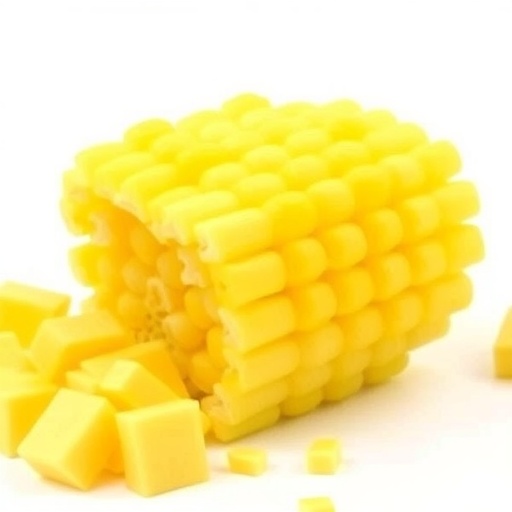In an innovative development within the realm of biomass conversion, researchers have made significant strides in transforming agricultural waste into valuable chemicals. The focus of this new study revolves around the conversion of hemicellulose extracted from corncobs into furfural, a chemical compound with extensive industrial applications. The research showcases not only the potential of utilizing agricultural byproducts effectively but also highlights the capabilities of advanced catalysts in facilitating complex chemical transformations.
Hemicellulose is a polysaccharide that, alongside cellulose and lignin, constitutes the primary components of plant cell walls. It is primarily found in the biomass of several plants, especially those categorized under agricultural residues such as corncobs. This study emphasizes a strategic extraction of hemicellulose from corncobs, which are often discarded as waste. By converting these raw materials into furfural, researchers are effectively promoting a circular economy strategy that reduces waste and enhances resource utilization.
Furfural is a furan derivative that is widely recognized for its versatility in chemical manufacturing. It serves as an essential building block for the production of biofuels, solvents, and chemical intermediates. However, the traditional methods of synthesizing furfural often involve harsh chemicals and unsustainable practices. This study proposes a greener alternative that leverages the natural properties of hemicellulose, thereby leading to a more environmentally friendly production pathway.
A noteworthy aspect of the research is the use of sulfonated graphitic carbon nitride (g-C3N4) as a catalyst in the reaction process. Graphitic carbon nitride is a promising material in catalytic applications due to its excellent stability and unique photocatalytic properties. By sulfonating this catalyst, the researchers enhanced its efficiency, making it a more effective agent in converting hemicellulose into furfural. This innovative approach stands to address the critical need for sustainable catalytic processes in industrial applications.
The experimental results from the study indicated that the sulfonated g-C3N4 catalyst significantly improved the yield of furfural from hemicellulose. Not only did the catalyst facilitate the breakdown of complex carbohydrates into simpler sugars, but it also played a crucial role in the subsequent dehydration to furfural. The researchers meticulously optimized various reaction conditions such as temperature, time, and catalyst concentration to find the ideal parameters for maximum conversion efficiency.
The study further explores the environmental implications of this conversion process. By utilizing waste materials such as corncobs, the researchers not only reduce the demand for virgin raw materials but also minimize the environmental impact associated with agricultural practices. This sustainable approach aligns with current global initiatives aimed at reducing carbon footprints and advancing eco-friendly technologies.
In related findings, the researchers also investigated the photodegradation of methylene blue, a common synthetic dye known for its detrimental ecological effects. In this process, sulfonated g-C3N4 was again utilized as a catalyst, demonstrating its dual functionality in biomass conversion and environmental remediation. The ability of the catalyst to harness light for the degradation of toxic compounds further underscores its potential in addressing prominent environmental issues, such as water pollution.
By integrating these two significant aspects — the conversion of biomass into valuable chemicals and the degradation of harmful pollutants — this study exemplifies a comprehensive approach towards sustainability. The potential industrial applications of the findings are substantial, paving the way for novel pathways in both the chemical and environmental sectors.
Moreover, the implications of this research extend beyond immediate applications. The transition towards using biomass as a sustainable resource is critical in the context of climate change and resource depletion. The study highlights the importance of developing innovative technologies that prioritize renewable sources and reduce the dependency on fossil fuels. This transition not only benefits the environment but also fosters economic opportunities in the realm of green chemistry.
Collaboration between academia and industry will be instrumental in advancing these findings toward practical applications. As manufacturers seek to adopt more sustainable practices, the insights gained from this research provide valuable knowledge that can inform the development of new industrial processes. It is expected that further innovations in catalyst design will lead to even greater efficiency and cost-effectiveness in biomass conversion technologies.
As public awareness of environmental issues grows, there is increasing demand for sustainable solutions across all sectors. This research taps into evolving trends in biomaterials and green chemistry, making it timely and relevant in today’s context. The findings emphasize that the future of sustainable chemical processes lies in the innovative utilization of available resources and the integration of advanced catalytic technologies.
In conclusion, the conversion of hemicellulose from corncobs into furfural, alongside the photodegradation of methylene blue using sulfonated g-C3N4, marks a significant advancement in the fields of bioengineering and environmental science. This research not only exemplifies the potential of agricultural waste but also reinforces the critical importance of sustainable practices in the fight against pollution and resource depletion. As further investigations are conducted and this research progresses toward commercialization, the outcomes hold great promise for a more sustainable and eco-friendly future.
Subject of Research: Biomass Conversion and Environmental Remediation
Article Title: Conversion of Hemicellulose from Corncob to Furfural and Photodegradation of Methylene Blue Using Sulfonated Graphitic Carbon Nitride as a Catalyst
Article References:
Hieu, N.T.N., Nam, N.M.H., Duyen, T.H. et al. Conversion of Hemicellulose from Corncob to Furfural and Photodegradation of Methylene Blue Using Sulfonated Graphitic Carbon Nitride as a Catalyst. Waste Biomass Valor (2025). https://doi.org/10.1007/s12649-025-03289-x
Image Credits: AI Generated
DOI: 10.1007/s12649-025-03289-x
Keywords: Biomass Conversion, Furfural, Hemicellulose, Sulfonated Graphitic Carbon Nitride, Photodegradation, Environmental Science, Sustainable Practices




